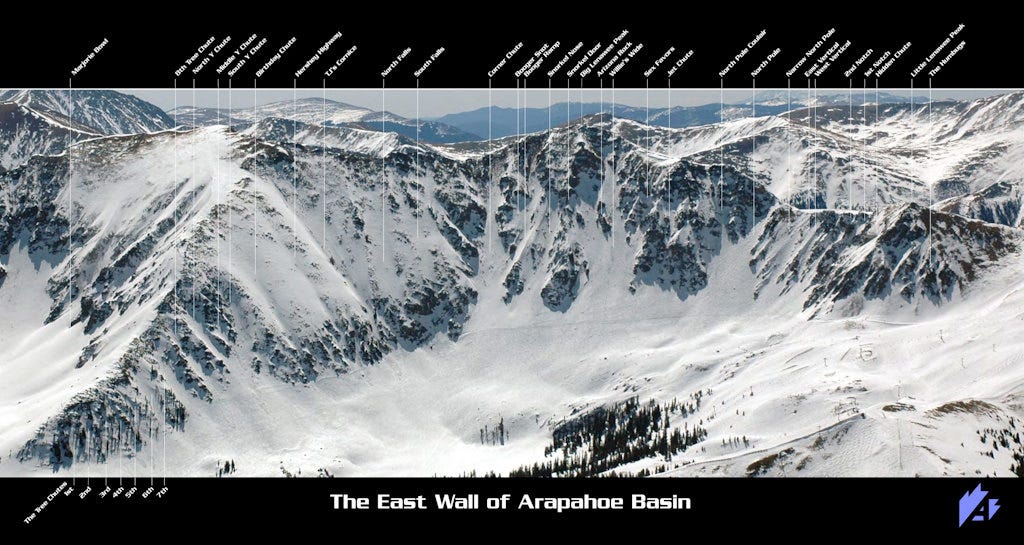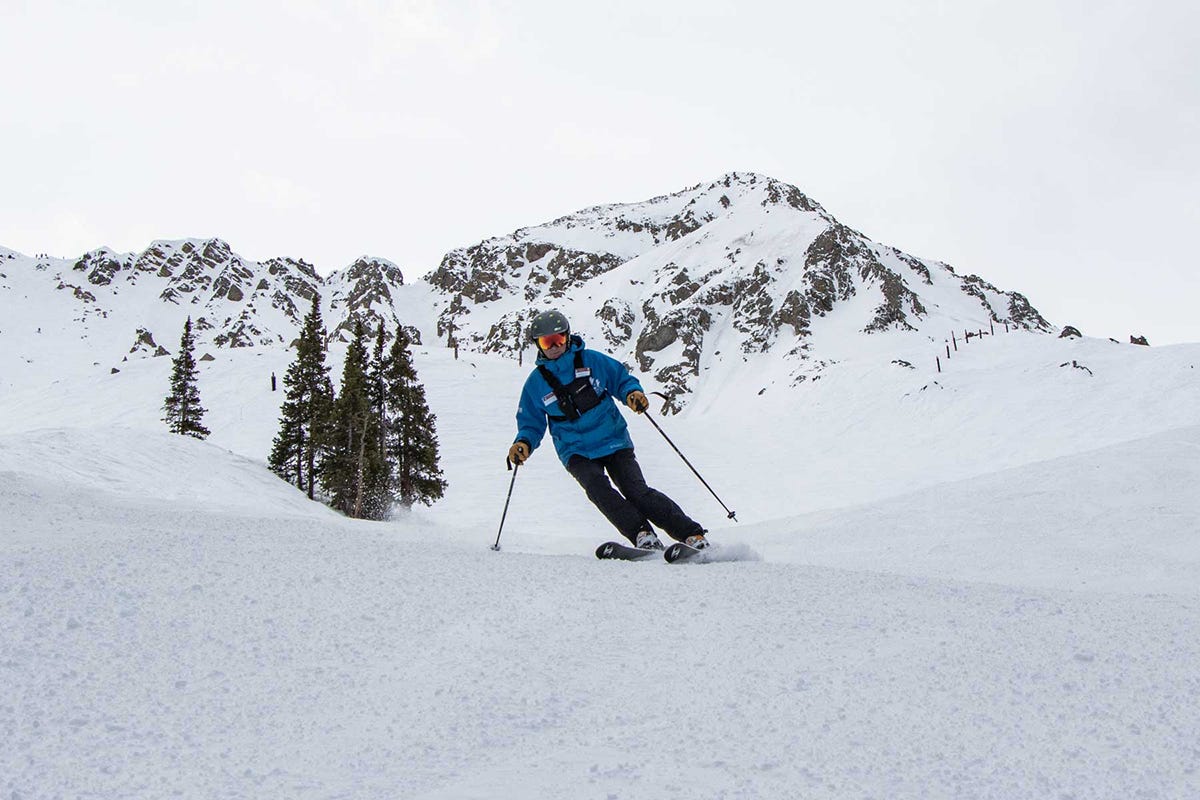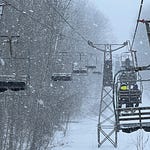Who
Alan Henceroth, Chief Operating Officer of Arapahoe Basin, Colorado
Recorded on
April 12, 2022
About Arapahoe Basin
Click here for a mountain stats overview
Owned by: Dundee Resort Development
Base elevation: 10,520 feet
Summit elevation: 13,050 feet
Vertical drop: 2,530 feet
Skiable Acres: 1,428
Average annual snowfall: 350 inches
Trail count: 147 (24% double-black, 49% black, 20% intermediate, 7% beginner)
Lift count: 9 (1 high-speed quad, 3 fixed-grip quads, 1 triple [to be replaced with a high-speed six-pack this summer], 1 double, 2 carpets, 1 J-tow - view Lift Blog’s inventory of Arapahoe Basin’s lift fleet)
Uphill capacity: 11,300 skiers per hour

Why I interviewed him
The Legend. Ski area taglines are typically rocket fuel for The Storm’s wiseass machine, but this one fits. Hard against the Continental Divide, Arapahoe Basin is the third-highest ski area in America, trailing only Monarch (10,790 feet) and Loveland (10,800) at its base, and Telluride (13,150) and Silverton (13,487), at its peak. Its legacy is 10th Mountain Division resourcefulness, an improbable place rising up and over the treeline, hacked out of the remote 1940s American wilderness. The ski area opens in October. It closes in June. Sometimes later (sometimes much later). In Conglomerate County USA, it is the rowdy independent, owned by Some Company Up In Canada, its extremes laced with ferocious double-blacks. There is no lodging. No phony village. No special rich-guy lanes. Just skiing.
Damn good skiing, fed by 350 inches of average annual snowfall. This is a ski area, not a ski resort. And in approachable Summit County, with its green-blue acres appropriately tilted for destination-wired Texans and New Yorkers, its groves of high-speed super-lifts, its sprawling mountains perfectly divided by ability, we might assume that such a rowdy outfit, five miles past faux-village Keystone, half the size and with six fewer high-speed chairlifts, might wilt from the pressure. But A-Basin has a pull. Sort North America’s ski areas by size, and the bias is clear: just about any western resort under 2,000 acres was left off the Epic, Ikon, and Mountain Collective passes. But when Arapahoe Basin broke up with Vail in 2019, after a 22-year-partnership, Ikon and Mountain Collective were waiting in the driveway with a dozen roses and a ride to prom. Meanwhile, Loveland, just three miles away, 300 acres bigger, and infinitely easier to get to (its address is literally Interstate 70, Dillon, Colorado), continues to be shut out (or they’re just not interested).
Anyone who’s skied there (and everyone has skied there), knows that Summit County is a special place. There’s a reason why it’s ground zero for America’s industrial snowsports machine. Copper, Breck, and Keystone have 79 lifts between them, including 10 six-packs, 16 high-speed quads, and four gondolas or chondolas. Eight and a half thousand acres of Epkonic terrain lurching within easy access of the interstate. And yet, there’s room for something different too. Something special. Something Legendary.
What we talked about
What the A-Basin crew does when Interstate 70 is closed and it’s dumping outside; the mountain’s 10th Mountain Division legacy; the audacity of 1946 A-Basin; what the ski area looked like when Henceroth showed up in 1988; the characters animating the mountain; ski-bumming and working in Summit County in the ‘80s; Arizona Snowbowl; yes a dog-food company used to own the ski area; The Legend’s terrain; recollections of rescues as Ski Patrol Director; the art of avalanche control; A-Basin’s unique position at the top of Summit County and at ground zero of every major issue in U.S. skiing; the hidden drama behind Vail’s purchase of Keystone, Breck, and A-Basin, and why the company had to pick one to sell; why and how A-Basin ended up on the Epic Pass; the historical inflection point that launched the large-scale ski season pass wars; the Epic Pass breaking point; breaking up with Vail – “it was a surprise to everyone”; the upsides of the Epic Pass; Vail’s stingy spring skiing legacy; how and why A-Basin joined the Ikon and Mountain Collective passes; what it meant for A-Basin to take its own pass back; how the skier experience has changed since the ski area left the Epic Pass; the parking problem; increasing uphill capacity while decreasing overall capacity by limiting ticket and pass sales; why A-Basin ditched its reservation system right after a two-week pilot in 2020; no more holiday blackouts on the Ikon Base Pass; why A-Basin finally installed a high-speed lift in 2010; why the ski area didn’t replace Pali with a higher-capacity lift; why A-Basin went with a fixed-grip quad at The Beavers even though it has twice the vertical rise of the high-speed Black Mountain lift; where you go once you have the newest lift fleet in the country; what the Montezuma Bowl expansion meant for the ski area; going deep on The Beavers expansion and why the lift is where it is; whether future terrain expansions are coming; the commitment to the long season; The Beach; and Al’s Blog.
Why I thought that now was a good time for this interview
Summit County is, unfortunately, too convenient for its own good. It is the first stop on the Ski Express heading west out of metropolitan Denver, where the population has nearly doubled in 30 years. It was, along with Winter Park, where the multi-mountain season pass wars erupted in the late ‘90s. Starting around 1998, a couple hundred bucks and a junker could get you an eight-month ski season in the high alpine. At the same time, air travel continued to get cheaper and Denver’s airport continued to expand. Anyone from anywhere could get to Colorado pretty easily, and over time the expressway into the mountains became a parking lot with a view.
A-Basin rode this tsunami for a long time. An inaugural member of the Epic Pass in 2008, the ski area was also part of the bargain-basement Summit County version of the product, which delivered unlimited access to Arapahoe Basin and Keystone (along with non-holidays at Breck), for around $500 (past prices are tough to nail down, but the pass was $419 in 2012 and appeared to rise to $549 by 2018; versions without Breck access were even cheaper). It was a hell of a deal, but it nearly broke the ski area. By 2019, when the mountain shocked Vail, skiers, and the whole industry by saying “yeah we’re done,” parking – the foundation of the whole U.S. American lift-served ski experience – was well beyond maxed-out for half of A-Basin’s eight-month season.
Exhausted and nearly defeated, the ski area needed a breather. The mountain that A-Basin had become was not the mountain it wanted or imagined itself to be. So Henceroth and his team rethought everything. They started limiting day ticket and season pass sales. For next season, they will actually decrease the number of passes by 10 percent of 2021-22 totals. They joined the Ikon and Mountain Collective passes, but as limited-day partners. This season, they will yank the 21-year-old Lenawee triple and drop a high-speed six-pack in its place (the triple is headed down I-70 to Sunrise). All of this came on top of the 468-acre Beavers and Steep Gullies expansion in 2018, which considerably boosted the ski area’s size and came with a new quad.
The headline here: Arapahoe Basin is decreasing overall capacity while increasing uphill capacity. It’s not a completely novel strategy: Deer Valley was built on limited tickets and fast, insanely numerous lifts. But A-Basin is doing this without the luxury sheen or high-dollar pricetag (their season pass is $559 for 2022-23, while Deer Valley’s clocks in at $2,675). And, more interestingly, it’s working: Henceroth tells me on the podcast that the ski area has never been in better fiscal shape, even as it’s shed 200,000 annual skier visits in the past four years. It’s a remarkable narrative, and one that many other ski areas, I suspect, will copy. Many other big-dogs – Alta, Jackson Hole, Aspen – are also aggressively adjusting pass products or tweaking parking or ramping up lift fleets. A-Basin, however, has been arguably the most aggressive and outspoken, a story told one blog post at a time, a real-time experiment in how big-time skiing in a big-time ski market can approach rationality in the megapass era and amid an exploding population. It was a story I had to hear.
Questions I wish I’d asked
I had a few questions prepared around the mountain’s long-term snowmaking plans, as well as a bit about why the ski area has no lodging (I think it’s the difficulty guests have sleeping at that altitude).
What I got wrong
When I referenced the elimination of Ikon Base holiday blackouts at A-Basin for next season, I said that there were no restrictions over “Christmas, New Year’s, and MLK.” That should have been the standard blackout periods of Christmas-to-New Year’s, MLK, and Presidents’ Day weekend, as outlined on the Ikon Pass website.
Why you should ski Arapahoe Basin
There’s something special about the top of America, where the trees meet the snowfields and peaks rise stark and lonesome beyond. To have skiing up there – to have anything up there – is disorienting and marvelous, a triumph of spirit and will. This is not Europe, where you’ll ride packed tram cars to a mountain-top abutment more impossible-seeming to anchor into than the surface of the moon. But it’s dramatic nonetheless, a sense of yeah-so-this-is-Colorado that will linger forever once absorbed.
A-Basin has a few greens, a small collection of blues, a pair of carpets wheeling along at the base. But this is an expert’s mountain. See the East Wall terrain on the map above, or anything off Pali, or the elevator shafts dropping from the Zuma Cornice. This is not Keystone, with its 10-mile cruisers and good stuff hidden three humps from the front-side. A-Basin’s gnar hangs there, looming and unmissable, a reach goal or psychological torture device for the groomer-bound or the uninitiated. It’s still Summit County: busy, pass-aligned, easy to get to, but it soars in a way that Copper, Keystone, and Breck – all incredible mountains – just don’t. It’s a little more Tahoe, a little more Jackson, a little more Cottonwoods than its Colorado neighbors, with a bit more edge and a bit more muscle, something both among and apart from them.
More Arapahoe Basin
Al’s Blog is one of the best ski-area blogs in the country. Posts exploring some of the items we discussed on the podcast:
Why A-Basin replaced its “1978 YAN fixed grip double chairlift with a capacity of 1,200 people per hour for a 2020 Leitner Poma fixed grip double chairlift with a capacity of 1,200 people per hour.”
Why the ski area exited the Epic Pass
Numbers-based breakdowns of A-Basin’s post-Epic life from 2020, and again from earlier this year.
A good breakdown (playing off the 2020 post above), by The Colorado Sun’s Jason Blevins: Arapahoe Basin’s effort to avoid overcrowding by leaving the Epic Pass may be working too well
Henceroth and I discussed Winter Park’s first buddy pass discount, which ignited the Colorado pass wars in 1998. This 2004 retrospective from The Summit Daily provides some good history, along with some funny-to-hear-now predictions from concerned ski industry veterans.
On the podcast, Henceroth mentions a ski magazine cover that credited “Vail Resorts” with a 243-day season after A-Basin (which was then part of the Epic Pass), extended their season deep into summer. I mentioned that I would try and track this magazine (or an image of it online), down, but I was unable to. If anyone has this cover, please send me a photo and I’ll include it in a future newsletter.
This trailmap of A-Basin, from 1967, is the oldest I could find:
The Storm publishes year-round, and guarantees 100 articles per year. This is article 40/100 in 2022. Want to send feedback? Reply to this email and I will answer. You can also email skiing@substack.com.


















